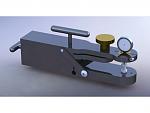Hi Bert,
I have had an idea of how to create a tool to check whether the rails are planar that doesn't matter if the laser line is bent.
It is effectively a large scale repeat-o-meter using the laser rather than DTI and thereby avoiding a very long infinitely stiff top bar:

The setup would consist of 4 spherical feet arranged in a square. 3 of these feet would be rigidly mounted on a triangular frame, the fourth foot would float on an arm that can pivot up and down on a hinge at the centre of the square. The camera would be fixed above this forth foot and the laser fixed to the triangular frame diagonally opposite. None of this would need to be high precision, the only requirement is that the triangle be stiff.
To calibrate the tool you could use any reasonably flat surface, it doesn't have to be a perfect plane but shouldn't be pitted.
Lay the tool on the surface and mark where the 4 feet touch as accurately as you can. Take a height reading of the laser on the sensor. Now lift the tool and rotate it 90 degrees such that the feet sit back on the 4 marks made and take another height reading. I think that the middle of the two height readings will be the point where all 4 feet are in plane, so we zero the tool to this mid point.
If this is a new machine then you would level the master rail bed in isolation using the laser projecting along it.
Now place the new calibrated tool on the machine frame such that two feet of the triangle rest on the master rail bed and the other two on the slave rail bed. Now adjust the slave rail bed under the floating foot until you read zero. These four points on the machine are now in plane. You can check the tool is still calibrated by rotating it 90 degrees on the machine frame and checking for zero.
We now have two points on the slave rail bed that are planar with the master so the slave rail bed can now be levelled in isolation to a line passing through these two points.

I think this a similar approach to using two crossed wires between 4 points to check for plane when the wires just touch, but this should be much more accurate.
If you had a machine where the two rail beams are adjustable at the ends then this would be an extremely simple way to bring them into plane.
Cheers, Joe











 Reply With Quote
Reply With Quote
Bookmarks